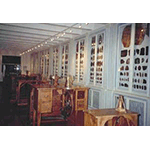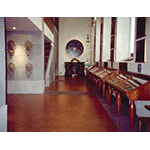Museo dell'Opificio delle Pietre Dure [Museum of the Opificio delle Pietre Dure]
In 1588 Ferdinand I de' Medici founded in the grand-ducal workshops, located in a wing of the Uffizi, a court manufactory, the first beginnings of the Opificio delle Pietre Dure (OPD). The manufactory, which was engaged for years in decorating the Chapel of the Princes, fabricated precious works with polychrome stones. The Opificio's production is an extraordinary example of the harmonious combining of art, technique and nature.
Particularly famous and esteemed was the so-called "commesso fiorentino", whose fabrication could take even a year or more of patient work. "Commesso fiorentino", originating in the late 16th century, is a "painting made of stone" which imitates the pictorial model. It is formed of an amazing combination of irregularly cut pieces of semiprecious stone, which are applied to a base, usually slate, which remains invisible. When the work is completed the junctures are almost imperceptible. Special machines were used to cut the pieces of stone rapidly and precisely. A wide range of subjects was represented: vivacious compositions of flowers and fruit, brightly feathered birds and naturalist scenes, architectural vedute and landscapes, portraits and stories from the Bible. These works were fabricated not only for the grand-ducal residences, but also for the most prominent families in Europe; as a result, the Opificio's artistic production is found throughout the world today.
In the late 19th century the Opificio, now without the Court or suitable clients, began to dedicate its superb technical skill to the restoration of Italy's architectural and sculptural heritage. At present the Opificio delle Pietre Dure is the seat of a prestigious state school of restoration, a modern, highly qualified scientific restoration laboratory, a centre of research on climatology, a library highly specialised in the field of restoration, and a museum. The latter documents the past artistic production of the Opificio, from the 16th to the 19th century. In addition to remarkable works in semiprecious stone, the museum displays the benches and instruments utilised for the work and samples of the semiprecious stones used or collected by the Opificio.
****************************
Texts by Graziano Magrini
English translation by Catherine Frost
Last update 02/gen/2008





